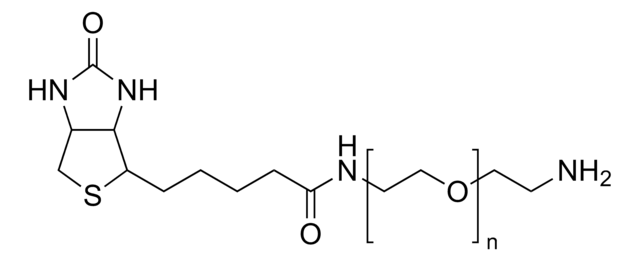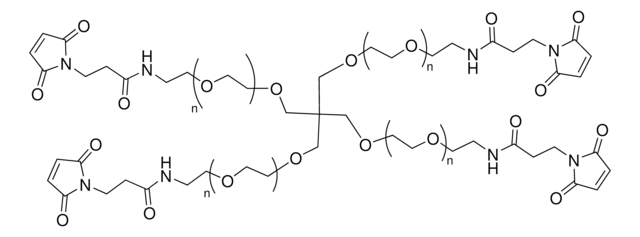757748
Poly(ethylene glycol) [N-(2-maleimidoethyl)carbamoyl]methyl ether 2-(biotinylamino)ethane
average Mn 5,400
Synonym(s):
Biotin polyoxyethylene maleimide, Biotin-PEG, Biotin-PEG-maleimide, Biotinylated PEG
About This Item
Recommended Products
form
solid
mol wt
PEG average Mn 5,000 (n~110)
average Mn 5,400
reaction suitability
reagent type: cross-linking reagent
reactivity: thiol reactive
mp
47-52 °C
Ω-end
maleimide
α-end
biotin
polymer architecture
shape: linear
functionality: heterobifunctional
storage temp.
−20°C
Application
Storage Class Code
11 - Combustible Solids
WGK
WGK 3
Flash Point(F)
Not applicable
Flash Point(C)
Not applicable
Regulatory Listings
Regulatory Listings are mainly provided for chemical products. Only limited information can be provided here for non-chemical products. No entry means none of the components are listed. It is the user’s obligation to ensure the safe and legal use of the product.
JAN Code
757748-100MG:
757748-BULK:
757748-VAR:
Choose from one of the most recent versions:
Certificates of Analysis (COA)
Don't see the Right Version?
If you require a particular version, you can look up a specific certificate by the Lot or Batch number.
Already Own This Product?
Find documentation for the products that you have recently purchased in the Document Library.
Customers Also Viewed
Articles
Devising biomaterial scaffolds that are capable of recapitulating critical aspects of the complex extracellular nature of living tissues in a threedimensional (3D) fashion is a challenging requirement in the field of tissue engineering and regenerative medicine.
Our team of scientists has experience in all areas of research including Life Science, Material Science, Chemical Synthesis, Chromatography, Analytical and many others.
Contact Technical Service

![2-{2-[2-(2-Mercaptoethoxy)ethoxy]ethoxy}ethanol 97%](/deepweb/assets/sigmaaldrich/product/structures/130/969/7d2ec2b4-e0f1-4836-aeb2-139994173612/640/7d2ec2b4-e0f1-4836-aeb2-139994173612.png)







![O-[N-(6-Maleimidohexanoyl)aminoethyl]-O′-[3-(N-succinimidyloxy)-3-oxopropyl]polyethylene glycol 3,000 Mp 3,000](/deepweb/assets/sigmaaldrich/product/structures/296/558/8fba6773-c240-41a2-ac1d-15c2185ceddd/640/8fba6773-c240-41a2-ac1d-15c2185ceddd.png)
![O-(2-Aminoethyl)-O′-[2-(biotinylamino)ethyl]octaethylene glycol ≥95% (oligomer uniformity)](/deepweb/assets/sigmaaldrich/product/structures/300/798/e23e92b4-9ae0-4a8d-a37e-d57a8195a30e/640/e23e92b4-9ae0-4a8d-a37e-d57a8195a30e.png)


